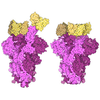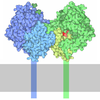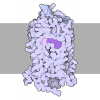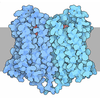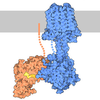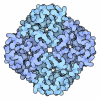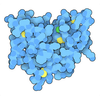[English] 日本語
 Yorodumi
Yorodumi- PDB-8u26: Gaussian Mixture Models based single particle refinement - GPCR (... -
+ Open data
Open data
- Basic information
Basic information
| Entry | Database: PDB / ID: 8u26 | ||||||
|---|---|---|---|---|---|---|---|
| Title | Gaussian Mixture Models based single particle refinement - GPCR (Substance P bound to active human neurokinin 1 receptor in complex with miniGs399 from EMPIAR-10786) | ||||||
 Components Components |
| ||||||
 Keywords Keywords | MEMBRANE PROTEIN / GPCR | ||||||
| Function / homology |  Function and homology information Function and homology informationsubstance P receptor binding / substance P receptor activity / positive regulation of corticosterone secretion / tachykinin receptor activity / positive regulation of flagellated sperm motility / aggressive behavior / Tachykinin receptors bind tachykinins / sperm ejaculation / positive regulation of uterine smooth muscle contraction / insemination ...substance P receptor binding / substance P receptor activity / positive regulation of corticosterone secretion / tachykinin receptor activity / positive regulation of flagellated sperm motility / aggressive behavior / Tachykinin receptors bind tachykinins / sperm ejaculation / positive regulation of uterine smooth muscle contraction / insemination / positive regulation of synaptic transmission, cholinergic / detection of abiotic stimulus / operant conditioning / positive regulation of lymphocyte proliferation / tachykinin receptor signaling pathway / response to ozone / sperm head / positive regulation of action potential / response to auditory stimulus / positive regulation of acute inflammatory response / positive regulation of blood pressure / smooth muscle contraction involved in micturition / regulation of smooth muscle cell proliferation / positive regulation of vascular permeability / positive regulation of hormone secretion / positive regulation of ossification / regulation of smooth muscle cell migration / positive regulation of leukocyte migration / eating behavior / negative regulation of heart rate / response to pain / positive regulation of vasoconstriction / behavioral response to pain / angiotensin-mediated drinking behavior / associative learning / positive regulation of epithelial cell migration / PKA activation in glucagon signalling / response to electrical stimulus / developmental growth / hair follicle placode formation / long-term memory / D1 dopamine receptor binding / neuropeptide signaling pathway / intracellular transport / sperm flagellum / neuronal dense core vesicle / vascular endothelial cell response to laminar fluid shear stress / renal water homeostasis / activation of adenylate cyclase activity / Hedgehog 'off' state / adenylate cyclase-activating adrenergic receptor signaling pathway / positive regulation of stress fiber assembly / response to hormone / sperm midpiece / sensory perception of pain / cellular response to glucagon stimulus / regulation of insulin secretion / response to progesterone / adenylate cyclase activator activity / trans-Golgi network membrane / positive regulation of epithelial cell proliferation / positive regulation of synaptic transmission, GABAergic / response to nicotine / negative regulation of inflammatory response to antigenic stimulus / cellular response to nerve growth factor stimulus / bone development / platelet aggregation / regulation of blood pressure / cognition / G-protein beta/gamma-subunit complex binding / adenylate cyclase-activating G protein-coupled receptor signaling pathway / Olfactory Signaling Pathway / Activation of the phototransduction cascade / G beta:gamma signalling through PLC beta / Presynaptic function of Kainate receptors / Thromboxane signalling through TP receptor / G protein-coupled acetylcholine receptor signaling pathway / Activation of G protein gated Potassium channels / Inhibition of voltage gated Ca2+ channels via Gbeta/gamma subunits / G-protein activation / Prostacyclin signalling through prostacyclin receptor / G beta:gamma signalling through CDC42 / Glucagon signaling in metabolic regulation / G beta:gamma signalling through BTK / Synthesis, secretion, and inactivation of Glucagon-like Peptide-1 (GLP-1) / ADP signalling through P2Y purinoceptor 12 / photoreceptor disc membrane / Sensory perception of sweet, bitter, and umami (glutamate) taste / Glucagon-type ligand receptors / Adrenaline,noradrenaline inhibits insulin secretion / Vasopressin regulates renal water homeostasis via Aquaporins / sensory perception of smell / Glucagon-like Peptide-1 (GLP1) regulates insulin secretion / G alpha (z) signalling events / cellular response to catecholamine stimulus / ADORA2B mediated anti-inflammatory cytokines production / ADP signalling through P2Y purinoceptor 1 / G beta:gamma signalling through PI3Kgamma / Cooperation of PDCL (PhLP1) and TRiC/CCT in G-protein beta folding / adenylate cyclase-activating dopamine receptor signaling pathway Similarity search - Function | ||||||
| Biological species |  Homo sapiens (human) Homo sapiens (human) | ||||||
| Method | ELECTRON MICROSCOPY / single particle reconstruction / cryo EM / Resolution: 2.5 Å | ||||||
 Authors Authors | Chen, M. / Pintilie, G. | ||||||
| Funding support |  United States, 1items United States, 1items
| ||||||
 Citation Citation |  Journal: Nat Methods / Year: 2024 Journal: Nat Methods / Year: 2024Title: Improving resolution and resolvability of single-particle cryoEM structures using Gaussian mixture models. Authors: Muyuan Chen / Michael F Schmid / Wah Chiu /  Abstract: Cryogenic electron microscopy is widely used in structural biology, but its resolution is often limited by the dynamics of the macromolecule. Here we developed a refinement protocol based on Gaussian ...Cryogenic electron microscopy is widely used in structural biology, but its resolution is often limited by the dynamics of the macromolecule. Here we developed a refinement protocol based on Gaussian mixture models that integrates particle orientation and conformation estimation and improves the alignment for flexible domains of protein structures. We demonstrated this protocol on multiple datasets, resulting in improved resolution and resolvability, locally and globally, by visual and quantitative measures. | ||||||
| History |
|
- Structure visualization
Structure visualization
| Structure viewer | Molecule:  Molmil Molmil Jmol/JSmol Jmol/JSmol |
|---|
- Downloads & links
Downloads & links
- Download
Download
| PDBx/mmCIF format |  8u26.cif.gz 8u26.cif.gz | 461.5 KB | Display |  PDBx/mmCIF format PDBx/mmCIF format |
|---|---|---|---|---|
| PDB format |  pdb8u26.ent.gz pdb8u26.ent.gz | 300.4 KB | Display |  PDB format PDB format |
| PDBx/mmJSON format |  8u26.json.gz 8u26.json.gz | Tree view |  PDBx/mmJSON format PDBx/mmJSON format | |
| Others |  Other downloads Other downloads |
-Validation report
| Summary document |  8u26_validation.pdf.gz 8u26_validation.pdf.gz | 1 MB | Display |  wwPDB validaton report wwPDB validaton report |
|---|---|---|---|---|
| Full document |  8u26_full_validation.pdf.gz 8u26_full_validation.pdf.gz | 1 MB | Display | |
| Data in XML |  8u26_validation.xml.gz 8u26_validation.xml.gz | 37.9 KB | Display | |
| Data in CIF |  8u26_validation.cif.gz 8u26_validation.cif.gz | 57.7 KB | Display | |
| Arichive directory |  https://data.pdbj.org/pub/pdb/validation_reports/u2/8u26 https://data.pdbj.org/pub/pdb/validation_reports/u2/8u26 ftp://data.pdbj.org/pub/pdb/validation_reports/u2/8u26 ftp://data.pdbj.org/pub/pdb/validation_reports/u2/8u26 | HTTPS FTP |
-Related structure data
| Related structure data |  41840MC 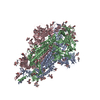 8u28C 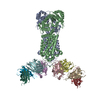 8u2cC M: map data used to model this data C: citing same article ( |
|---|---|
| Similar structure data | Similarity search - Function & homology  F&H Search F&H Search |
| Experimental dataset #1 | Data reference:  10.6019/EMPIAR-10786 / Data set type: EMPIAR 10.6019/EMPIAR-10786 / Data set type: EMPIAR |
- Links
Links
- Assembly
Assembly
| Deposited unit | 
|
|---|---|
| 1 |
|
- Components
Components
-Guanine nucleotide-binding protein ... , 3 types, 3 molecules ABG
| #1: Protein | Mass: 28907.684 Da / Num. of mol.: 1 Source method: isolated from a genetically manipulated source Source: (gene. exp.)  Homo sapiens (human) / Gene: GNAS, GNAS1, GSP / Production host: Homo sapiens (human) / Gene: GNAS, GNAS1, GSP / Production host:  Homo sapiens (human) / References: UniProt: P63092 Homo sapiens (human) / References: UniProt: P63092 |
|---|---|
| #2: Protein | Mass: 40786.566 Da / Num. of mol.: 1 Source method: isolated from a genetically manipulated source Source: (gene. exp.)  Homo sapiens (human) / Gene: GNB1 / Production host: Homo sapiens (human) / Gene: GNB1 / Production host:  Homo sapiens (human) / References: UniProt: P62873 Homo sapiens (human) / References: UniProt: P62873 |
| #3: Protein | Mass: 7563.750 Da / Num. of mol.: 1 Source method: isolated from a genetically manipulated source Source: (gene. exp.)  Homo sapiens (human) / Gene: GNG2 / Production host: Homo sapiens (human) / Gene: GNG2 / Production host:  Homo sapiens (human) / References: UniProt: P59768 Homo sapiens (human) / References: UniProt: P59768 |
-Antibody / Protein / Protein/peptide , 3 types, 3 molecules NRS
| #4: Antibody | Mass: 15398.067 Da / Num. of mol.: 1 Source method: isolated from a genetically manipulated source Source: (gene. exp.)   |
|---|---|
| #5: Protein | Mass: 47542.867 Da / Num. of mol.: 1 Source method: isolated from a genetically manipulated source Source: (gene. exp.)  Homo sapiens (human) / Gene: TACR1, NK1R, TAC1R / Production host: Homo sapiens (human) / Gene: TACR1, NK1R, TAC1R / Production host:  Homo sapiens (human) / References: UniProt: P25103 Homo sapiens (human) / References: UniProt: P25103 |
| #6: Protein/peptide | Mass: 1350.629 Da / Num. of mol.: 1 Source method: isolated from a genetically manipulated source Source: (gene. exp.)  Homo sapiens (human) / Gene: TAC1, NKA, NKNA, TAC2 / Production host: Homo sapiens (human) / Gene: TAC1, NKA, NKNA, TAC2 / Production host:  Homo sapiens (human) / References: UniProt: P20366 Homo sapiens (human) / References: UniProt: P20366 |
-Details
| Has protein modification | Y |
|---|
-Experimental details
-Experiment
| Experiment | Method: ELECTRON MICROSCOPY |
|---|---|
| EM experiment | Aggregation state: PARTICLE / 3D reconstruction method: single particle reconstruction |
- Sample preparation
Sample preparation
| Component | Name: Substance P bound to active human neurokinin 1 receptor in complex with miniGs399 Type: COMPLEX Details: Reprocessing of EMPIAR-10786. Sample information is the same as EMD-24570, PDB-7RMH. Entity ID: all / Source: NATURAL |
|---|---|
| Molecular weight | Value: 0.141 MDa / Experimental value: YES |
| Source (natural) | Organism:  Homo sapiens (human) Homo sapiens (human) |
| Buffer solution | pH: 7.5 |
| Specimen | Embedding applied: NO / Shadowing applied: NO / Staining applied: NO / Vitrification applied: YES |
| Vitrification | Cryogen name: ETHANE |
- Electron microscopy imaging
Electron microscopy imaging
| Experimental equipment |  Model: Titan Krios / Image courtesy: FEI Company |
|---|---|
| Microscopy | Model: FEI TITAN KRIOS |
| Electron gun | Electron source:  FIELD EMISSION GUN / Accelerating voltage: 300 kV / Illumination mode: FLOOD BEAM FIELD EMISSION GUN / Accelerating voltage: 300 kV / Illumination mode: FLOOD BEAM |
| Electron lens | Mode: BRIGHT FIELD / Nominal defocus max: 2000 nm / Nominal defocus min: 1000 nm |
| Image recording | Electron dose: 30 e/Å2 / Film or detector model: GATAN K3 (6k x 4k) |
- Processing
Processing
| EM software |
| ||||||||||||||||||||||||
|---|---|---|---|---|---|---|---|---|---|---|---|---|---|---|---|---|---|---|---|---|---|---|---|---|---|
| CTF correction | Type: PHASE FLIPPING ONLY | ||||||||||||||||||||||||
| 3D reconstruction | Resolution: 2.5 Å / Resolution method: FSC 0.143 CUT-OFF / Num. of particles: 288659 / Symmetry type: POINT | ||||||||||||||||||||||||
| Atomic model building | Protocol: FLEXIBLE FIT / Space: REAL | ||||||||||||||||||||||||
| Refine LS restraints |
|
 Movie
Movie Controller
Controller






 PDBj
PDBj
